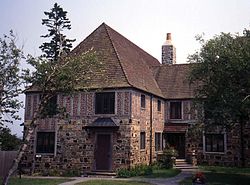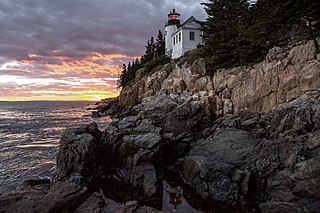
Acadia National Park is an American national park located along the mid-section of the Maine coast, southwest of Bar Harbor. The park preserves about half of Mount Desert Island, part of the Isle au Haut, the tip of the Schoodic Peninsula, and portions of 16 smaller outlying islands. It protects the natural beauty of the rocky headlands, including the highest mountains along the Atlantic coast. Acadia boasts a glaciated coastal and island landscape, an abundance of habitats, a high level of biodiversity, clean air and water, and a rich cultural heritage.
Sullivan is a town in Hancock County, Maine, United States. The population was 1,219 at the 2020 census. The town was named for Daniel Sullivan, an early settler. Colloquially referred to as "Sully" or "the Sullivans"—like many Maine municipalities composed of villages with geographic designations of the town proper—the municipality was incorporated in 1789. Located in the Upper Schoodic Peninsula sub-region of Maine's Downeast Acadia region, the municipality has been known as "Waukeag", "New Bristol", and later Sullivan; and once included the nearby communities of Hancock, Sorrento, and what would later be Township 7, South & Middle Districts. Once home to abundant granite quarries, the town of Sullivan is now a residential community for nearby Ellsworth and Mount Desert Island. Located along U.S. Route 1, the Taunton River, and Hog Bay, Sullivan is home to a reversing tidal falls and many scenic turnouts that dot the Schoodic National Scenic Byway along the Upper Schoodic Peninsula.
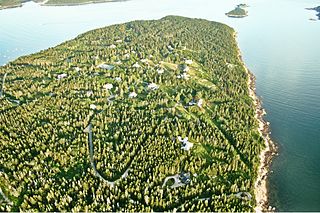
Winter Harbor is a town on the Schoodic Peninsula in Hancock County, Maine, United States. The population was 461 at the 2020 census. The town is located just outside the Schoodic Peninsula portion of Acadia National Park, and is due east of the town of Bar Harbor and Ellsworth. Winter Harbor was once the location of a US Naval Station, NSGA-WH, which closed in the mid-2000s, and is now home to the Schoodic Institute’s Education and Research Center.
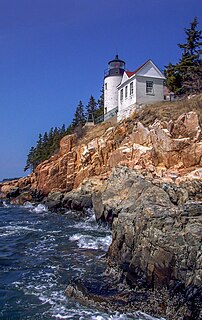
Mount Desert Island in Hancock County, Maine, is the largest island off the coast of Maine. With an area of 108 square miles (280 km2) it is the 52nd-largest island in the United States, the sixth-largest island in the contiguous United States, and the second-largest island on the Eastern Seaboard, behind Long Island and ahead of Martha's Vineyard. According to the 2010 census, the island has a year-round population of 10,615. In 2017, an estimated 3.5 million tourists visited Acadia National Park on MDI. The island is home to numerous well-known summer colonies such as Northeast Harbor and Bar Harbor.
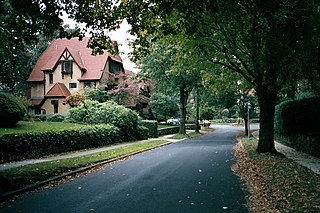
Grosvenor Atterbury was an American architect, urban planner and writer. He studied at Yale University, where he was an editor of campus humor magazine The Yale Record After travelling in Europe, he studied architecture at Columbia University and worked in the offices of McKim, Mead & White.
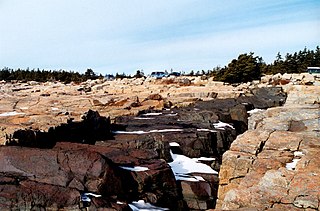
The Schoodic Peninsula is a peninsula in Down East Maine. It is located four miles (6 km) east of Bar Harbor, Maine, as the crow flies. The Schoodic Peninsula contains 2,266 acres (9 km2), or approximately 5% of Acadia National Park. It includes the towns of Gouldsboro and Winter Harbor. The peninsula has a rocky granite shoreline containing many volcanic dikes. The peninsula is home to the former United States Navy base, NSGA Winter Harbor, which has been converted into a National Park Service training center. A 3,300-acre (13 km2) resort development was proposed for land abutting Schoodic Peninsula's national park holdings to the north. An anonymous donor eventually bought the entire 3,200-acre tract and built the Schoodic Woods Campground and miles of gravel bike paths before donating all of it to Acadia National Park. Opening in 2015, Schoodic Woods is the newest campground in Acadia National Park, and the first built in the park since the original campgrounds were built by the Civilian Conservation Corps during the Great Depression beginning in 1936. In the summer, the Schoodic peninsula is currently served by two separate ferry services from Bar Harbor to Winter Harbor that run daily.

Fighter Squadron 114 (VF-114) was a fighter squadron of the United States Navy that was active from 1945 through 1993. Nicknamed the "Aardvarks", it was based out of Naval Air Station Miramar, California. The squadron flew combat missions during the Korean War and Vietnam War. VF-114 was disestablished as part of the post-Cold War drawdown of forces on April 30, 1993.

Naval Air Station Sanford was a naval air station of the United States Navy in Sanford, Florida, approximately 20 miles north of Orlando, Florida. Opening less than a year after the start of World War II, NAS Sanford's initial function was as an advanced training base for land-based patrol bombers, followed by carrier-based fighter aircraft. The air station briefly closed in 1946 and was placed in caretaker status until being reactivated in 1950. It eventually served as a Master Jet Base for carrier-based heavy attack and reconnaissance aircraft until 1969. After its closure, it reopened as civilian general aviation airport under various names with a non-Navy civilian airport identifier until finally transitioning to a scheduled air carrier airport under its current name of Orlando-Sanford International Airport.

CSS Acadia is a former hydrographic surveying and oceanographic research ship of the Hydrographic Survey of Canada and its successor the Canadian Hydrographic Service.

U.S. Naval Radio Station Otter Cliffs was a United States Navy radio receiver facility located in Acadia National Park on Mount Desert Island, south of Bar Harbor, Maine.

Air Development Squadron Six was a United States Navy Air Development Squadron based at McMurdo Station, Antarctica. Established at Naval Air Station Patuxent River, Maryland on 17 January 1955, the squadron's mission was to conduct operations in support of Operation Deep Freeze, the operational component of the United States Antarctic Program.

Antarctic Development Squadron Six was a United States Navy air test and evaluation squadron based at Naval Air Station Point Mugu, California with forward operating bases at Christchurch, New Zealand and McMurdo Station, Antarctica.

Established on 16 April 1964 as the Pacific Fleet Polaris Material Office (PMOPAC), the Priority Material Office (PMO) is headquartered at Naval Base Kitsap, Bremerton, Washington. PMO is a U.S. Naval command under the operational control of the Commander, Submarine Force, U. S. Pacific Fleet (COMSUBPAC). PMO is charged with providing dedicated logistics support to Pacific and Atlantic Fleet submarine forces, surface ship forces, Marine Corps, Coast Guard, and Military Sealift Command (MSC) units.

Fighter Squadron 92, or VF-92Silver Kings was an aviation unit of the United States Navy. Originally established as VF-92 on 26 March 1952, it was redesignated VF-54 on 1 June 1962, redesignated VF-92 on 15 October 1963, it was disestablished on 12 December 1975. It was the third US Navy squadron to be designated VF-92.

Naval Mobile Construction Battalion TWO SIX was a United States Navy Seabee battalion commissioned in 1942 for support to Naval Operations in the Pacific Theater in World War II and later a Reserve Naval Construction Battalion based in various locations in the Midwest from 1962 until 2014.

RVAH-13 was a Reconnaissance Attack (Heavy) Squadron of the U.S. Navy. Originally established as Heavy Attack Squadron Thirteen (VAH-13) on 3 January 1961 it was redesignated as Reconnaissance Attack (Heavy) Squadron Thirteen (RVAH-13) on 1 November 1964. The squadron was disestablished on 30 June 1976.
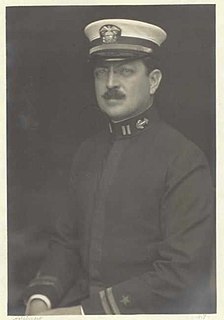
Alessandro Fabbri (1877–1922) was both the builder and the commanding officer of the Otter Cliffs Radio Station, a United States Navy facility that was important during World War I. He was awarded the Navy Cross for exceptionally meritorious service.

Laurence Allen Abercrombie, was a decorated commander during World War II who reached the rank of Rear Admiral in the United States Navy. Admiral Abercrombie was thrice awarded the Navy Cross, United States military's second-highest decoration awarded for valor in combat.
